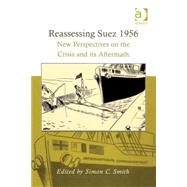Reassessing Suez 1956: New Perspectives on the Crisis and its Aftermath
, by Smith,Simon C.; Smith,Simon C.- ISBN: 9780754661702 | 0754661709
- Cover: Hardcover
- Copyright: 10/28/2008
In this two volume collection the editors have chosen a sample of some of the most essential and inspirational articles and papers for understanding revealed preference methods to value environmental amenities. The papers cover the gamut of methods that are typically classified as revealed preference approaches - including: recreation demand models, hedonic methods, and averting behavior methods, as well as efforts to combine stated and revealed preferences. While this collection is far from exhaustive, the editors have included papers they believe will represent the state of the art in the theory and application of revealed preference methods, contribute to development of the state of the art, or raise fundamental challenges and insights that will drive the research agenda in the coming years. Contents: Volume I: Recreation Demand: Theoretical Foundations: The effects of common sources of regression error on benefit estimates, N. Bockstael and I. Strand; The dual structure of incomplete demand systems, J. LaFrance and M. Hanemann; Recovering weakly complementary preferences, D. Larson; Public goods as characteristics of non market commodities, N. Bockstael and K. McConnell; A difficulty with travel cost method, A. Randall; A diagrammatic exposition of weak complementarity and the Willig condition, V.K. Smith and H.S. Banzhaf; What''s the use? Welfare estimates from revealed preference models when weak complementarity does not hold, J. A. Herriges, C.L. Kling and D.J. Phaneuf. Single Equation and Demand System Models: Estimating the value of water quality improvements in a recreational demand framework, N. Bockstael, W.M. Hannemann and C. Kling; Estimating a system of recreation demand function using a seemingly unrelated Poisson regressional approach, T. Ozuna and I.A. Gomez; Count data models and recreation demand, T.C. Haab and K.E. McConnell; Modeling recreation demand in a Poisson system of equations: an analysis of the impact of international exchange rates, J. Englin, P. Boxall and D Watson; 2 nested CES models of recreational participation and site choice: an ''alternatives'' model and an ''expenditures'' model, E. Morey, W. Breffle and P.Greene. Random Utility Maximization (RUM) Models: A repeated nested-logit model of Atlantic salmon fishing, E. Morey, R. Rowe and M. Watson; The implications of model specification for welfare estimation in nested logit models, C.L. Kling and C.J. Thompson; Recreation demand models with taste differences over people, K.E. Train; Nonlinear income effects in random utility models, J. Herriges and C. Kling; Inducing patterns of correlation in repeated logit models of recreation demand, J.A. Herriges and D. Phaneuf; Compensating variation and Hicksian choice probabilities in random utility models that are nonlinear in income, J.K. Dagsvik and A. Karlstrom; Handling unobserved site characteristics in random utility models of recreation demand, J. Murdock. Corner Solution Models: Discrete-continuous models of consumer demand, W.M. Hanemann; Searching for a model of multiple-site recreation demand that admits interior and boundary solutions, E. Morey, D. Waldman, D. Assane and W.D. Shaw; A dual approach to modeling corner solutions in recreation demand, D.J. Phaneuf; Estimation and welfare calculations in a generalized corner solution model with an application to recreation demand, D. J. Phaneuf, C.L. Kling and J.A. Herriges; Estimation and welfare analyses with large demand systems, R. von Haefen, D. Phaneuf and G. Parsons; Estimating preferences for outdoor recreation: a comparison of continuous and count data demand systems, R. von Haefen and D.J. Phaneuf. Defining the Choice Set: Site aggregation in a random utility model of recreation, G. Parsons and M. Needelman; Measuring recreation values with multiple-destination trips, R. Mendelsohn, J. Hof, G. Peterson and R. Johnson; Sampling and aggregation issues in random utility model estimation, P. Feather; Using random utility models to estimate







